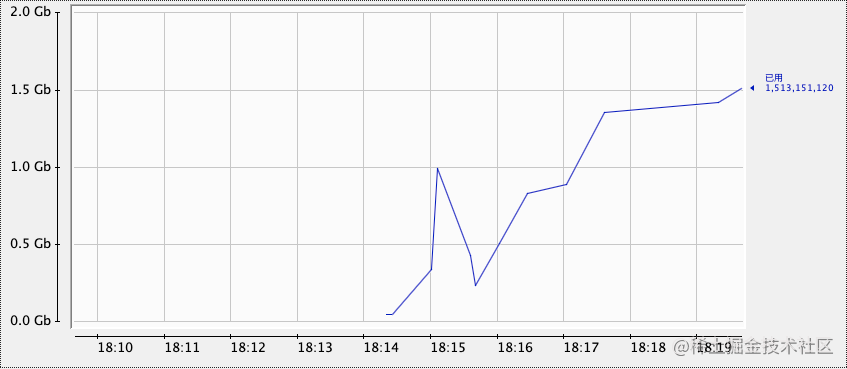SpringBoot Actuator潜在的OOM问题的解决_java
2022-03-01
目录
- 背景&问题
- 问题原因及解决
- 默认埋点是如何生效的
- http.client.requests 中的 uri
- 解决
- 会不会 OOM
此问题背景产生于近期需要上线的一个功能的埋点;主要表现就是在应用启动之后的一段时间内,内存使用一直呈现递增趋势。
下图为场景复线后,本地通过 jconsole 查看到的内部使用走势图。
实际环境受限于配置,内存不会膨胀
背景&问题
应用 a 使用 rest template 通过 http 方式调用 应用 b,应用项目中开启了 actuator,api 使用的是 micrometer;在 client 调用时,actuator 会产生一个 name 为 http.client.requests 的 metrics,此 metric 的 tag 中包含点目标的 uri。
应用 b 提供的接口大致如下:
@RequestMapping("test_query_params")
public String test_query_params(@RequestParam String value) {
return value;
}
@RequestMapping("test_path_params/{value}")
public String test_path_params(@PathVariable String value) {
return value;
}
http://localhost:8080/api/test/test_query_params?value=
http://localhost:8080/api/test/test_path_params/{value}_
期望在 metric 的收集结果中应该包括两个 metrics,主要区别是 tag 中的 uri 不同,一个是 api/test/test_query_params, 另一个是 api/test/test_path_params/{value};实际上从拿到的 metrics 数据来看,差异很大,这里以 pathvariable 的 metric 为例,数据如下:
tag: "uri", values: [ "/api/test/test_path_params/glmapper58", "/api/test/test_path_params/glmapper59", "/api/test/test_path_params/glmapper54", "/api/test/test_path_params/glmapper55", "/api/test/test_path_params/glmapper56", "/api/test/test_path_params/glmapper57", "/api/test/test_path_params/glmapper50", "/api/test/test_path_params/glmapper51", "/api/test/test_path_params/glmapper52", "/api/test/test_path_params/glmapper53", "/api/test/test_path_params/glmapper47", "/api/test/test_path_params/glmapper48", "/api/test/test_path_params/glmapper49", "/api/test/test_path_params/glmapper43", "/api/test/test_path_params/glmapper44", "/api/test/test_path_params/glmapper45", "/api/test/test_path_params/glmapper46", "/api/test/test_path_params/glmapper40", "/api/test/test_path_params/glmapper41", "/api/test/test_path_params/glmapper42", "/api/test/test_path_params/glmapper36", "/api/test/test_path_params/glmapper37", "/api/test/test_path_params/glmapper38", "/api/test/test_path_params/glmapper39", "/api/test/test_path_params/glmapper32", "/api/test/test_path_params/glmapper33", "/api/test/test_path_params/glmapper34", "/api/test/test_path_params/glmapper35", "/api/test/test_path_params/glmapper30", "/api/test/test_path_params/glmapper31", "/api/test/test_path_params/glmapper25", "/api/test/test_path_params/glmapper26", .... ]
可以非常明显的看到,这里将{value} 参数作为了 uri 组件部分,并且体现在 tag 中,并不是期望的 api/test/test_path_params/{value}。
问题原因及解决
两个问题,1、这个埋点是怎么生效的,先搞清楚这个问题,才能顺藤摸瓜。2、怎么解决。
默认埋点是如何生效的
因为是通过 resttemplate 进行调用访问,那么埋点肯定也是基于对 resttemplate 的代理;按照这个思路,笔者找到了 org.springframework.boot.actuate.metrics.web.client.MetricsRestTemplateCustomizer 这个类。RestTemplateCustomizer 就是对 resttemplate 进行定制的,MetricsRestTemplateCustomizer 通过名字也能得知期作用是为了给 resttemplate 增加 metric 能力。
再来讨论 RestTemplateCustomizer,当使用RestTemplateBuilder构建RestTemplate时,可以通过RestTemplateCustomizer进行更高级的定制,所有RestTemplateCustomizer beans 将自动添加到自动配置的RestTemplateBuilder。也就是说如果 想 MetricsRestTemplateCustomizer 生效,那么构建 resttemplate 必须通过 RestTemplateBuilder 方式构建,而不是直接 new。
http.client.requests 中的 uri
塞 tag 的代码在org.springframework.boot.actuate.metrics.web.client.RestTemplateExchangeTags 类中,作用时机是在 MetricsClientHttpRequestInterceptor 拦截器中。当调用执行完成后,会将当次请求 metric 记录下来,在这里就会使用到 RestTemplateExchangeTags 来填充 tags。 下面仅给出 uri 的部分代码
/**
* Creates a {@code uri} {@code Tag} for the URI of the given {@code request}.
* @param request the request
* @return the uri tag
*/
public static Tag uri(HttpRequest request) {
return Tag.of("uri", ensureLeadingSlash(stripUri(request.getURI().toString())));
}
/**
* Creates a {@code uri} {@code Tag} from the given {@code uriTemplate}.
* @param uriTemplate the template
* @return the uri tag
*/
public static Tag uri(String uriTemplate) {
String uri = (StringUtils.hasText(uriTemplate) ? uriTemplate : "none");
return Tag.of("uri", ensureLeadingSlash(stripUri(uri)));
其余的还有 status 和 clientName 等 tag name。
通过断点,可以看到,这里 request.getURI() 拿到的是带有参数的完整请求链接。
这些 tag 的组装最终在 DefaultRestTemplateExchangeTagsProvider 中完成,并返回一个 列表。
private Timer.Builder getTimeBuilder(HttpRequest request, ClientHttpResponse response) {
return this.autoTimer.builder(this.metricName)
// tagProvider 为 DefaultRestTemplateExchangeTagsProvider
.tags(this.tagProvider.getTags(urlTemplate.get().poll(), request, response))
.description("Timer of RestTemplate operation");
}
解决
这里先来看下官方对于 request.getURI 的解释
/**
* Return the URI of the request (including a query string if any,
* but only if it is well-formed for a URI representation).
* @return the URI of the request (never {@code null})
*/
URI getURI();
返回请求的 URI,这里包括了任何的查询参数。那么是不是拿到不用参数的 path 就行呢?
这里尝试通过 request.getURI().getPath() 拿到了预期的 path(@pathvariable 拿到的是模板)。
再回到 DefaultRestTemplateExchangeTagsProvider,所有的 tag 都是在这里完成组装,这个类明显是一个默认的实现(Spring 体系下基本只要是Defaultxxx 的,一般都能扩展 ),查看它的接口类 RestTemplateExchangeTagsProvider 如下:
/**
* Provides {@link Tag Tags} for an exchange performed by a {@link RestTemplate}.
*
* @author Jon Schneider
* @author Andy Wilkinson
* @since 2.0.0
*/
@FunctionalInterface
public interface RestTemplateExchangeTagsProvider {
/**
* Provides the tags to be associated with metrics that are recorded for the given
* {@code request} and {@code response} exchange.
* @param urlTemplate the source URl template, if available
* @param request the request
* @param response the response (may be {@code null} if the exchange failed)
* @return the tags
*/
Iterable<Tag> getTags(String urlTemplate, HttpRequest request, ClientHttpResponse response);
}
RestTemplateExchangeTagsProvider 的作用就是为 resttemplate 提供 tag 的,所以这里通过自定义一个 RestTemplateExchangeTagsProvider,来替换DefaultRestTemplateExchangeTagsProvider,以达到我们的目标,大致代码如下:
@Override
public Iterable<Tag> getTags(String urlTemplate, HttpRequest request, ClientHttpResponse response) {
Tag uriTag;
// 取 request.getURI().getPath() 作为 uri 的 value
if (StringUtils.hasText(request.getURI().getPath())) {
uriTag = Tag.of("uri", ensureLeadingSlash(stripUri(request.getURI().getPath())));
} else {
uriTag = (StringUtils.hasText(urlTemplate) ? RestTemplateExchangeTags.uri(urlTemplate)
: RestTemplateExchangeTags.uri(request));
}
return Arrays.asList(RestTemplateExchangeTags.method(request), uriTag,
RestTemplateExchangeTags.status(response), RestTemplateExchangeTags.clientName(request));
}
会不会 OOM
理论上,应该参数不同,在使用默认 DefaultRestTemplateExchangeTagsProvider 的情况下,meter 会随着 tags 的不同迅速膨胀,在 micrometer 中,这些数据是存在 map 中的
// Even though writes are guarded by meterMapLock, iterators across value space are supported // Hence, we use CHM to support that iteration without ConcurrentModificationException risk private final Map<Id, Meter> meterMap = new ConcurrentHashMap<>();
一般情况下不会,这里是因为 spring boot actuator 自己提供了保护机制,对于默认情况,tags 在同一个 metric 下,最多只有 100 个
/** * Maximum number of unique URI tag values allowed. After the max number of * tag values is reached, metrics with additional tag values are denied by * filter. */ private int maxUriTags = 100;
如果你想使得这个数更大一些,可以通过如下配置配置
management.metrics.web.client.max-uri-tags=10000
如果配置值过大,会存在潜在的 oom 风险。



